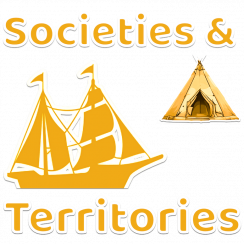Portrait of the territory
The territory of Upper Canada was located west of Montréal to the north of the Great Lakes. Its geography was similar to that of Lower Canada. There were many rivers and coniferous and deciduous forests.
The land was fertile and the climate was milder than in Lower Canada. The warmer climate allowed for better farming. The longer growing season also meant that different plants could be cultivated. Like Lower Canada, The relief of the territory made it good for farming.
The townships
Land was divided differently in Upper and Lower Canada. In New France, land was divided into seigneuries according to the French model. In Upper Canada, where the population was English, land was divided into townships, according to the English system.
This land was not divided into narrow strips, but into squares, which created a very different landscape.
In the townships, people who farmed the land did not have to give or pay anything to a seigneur because there were none. So there were no seigneurial fees to pay. But, to obtain a piece of land, people did have to pay a fee and prove that they were able to cultivate it.
Transportation
Upper Canada’s weakness was transportation. In Lower Canada, the St. Lawrence River allowed boats to travel from deep in the territory all the way to the Atlantic Ocean to do trade.
In Upper Canada, however, there was no sea port. In other words, there were no rivers that provided access to the Atlantic Ocean. To export goods, the people of Upper Canada had to go through Montréal or New York, which was very long.
In Upper Canada, there were also towns like Bytown. This town is well known today as Ottawa. It’s the capital of Canada.
Author: Léon Robichaud
See also
See also – Traces of the past:




